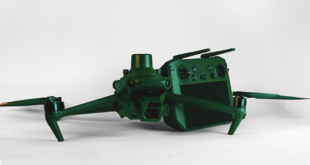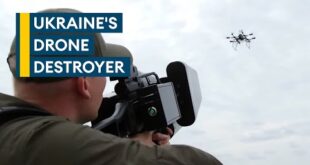
Vo2019, CC BY-SA 4.0
The Mohamed Bin Zayed International Robotics Challenge offers more than $3 million USD in prizes. This year, the Maritime Robotics Challenge is designed to bring emerging technologies together to tackle previously unsolvable challenges facing the maritime industry.
The following is a guest post by Dr. Art Morrish, CEO of ASPIRE, shaping the strategy and development of Abu Dhabi’s advanced technology sector. ASPIRE administers the MBZIRC Maritime Grand Challenge. DRONELIFE neither makes nor accepts payment for guest posts.
History is filled with what were believed to be unsolvable challenges. In just about every case, new technologies emerged to provide a solution. Take for example, putting a rover on Mars or a man on the moon. It was considered inconceivable for a long time. Now it’s a reality.
It’s rarely just one technology or a single “A-ha” moment. But rather it’s a combination of new technologies and collaboration between different groups of specialists that creates these successful breakthroughs.
Over the last several years, as drones have improved, the industry has seen applications for the technology improve exponentially. Once a purview of hobbyists, drones now check on infrastructure such as power lines and pipelines; provide additional security in remote locations and even deliver supplies during times of disaster.
Collaboration between Maritime Robotics, Drones, and AI
The drone service business will continue to grow with these types of applications, but forward-thinking drone companies and their engineers will be seeking out partnerships and collaboration with providers of these other technologies, to deliver services that were previously only found in science fiction books. Over the next several years, though, we will see that change, as different types current and emerging technologies – including robotics, unmanned vehicles, and AI – will be integrated with drone technology to address persistent problems in a number of industries.
Advancements in highly functional lightweight robotics technology, in tandem with connectivity technologies, are now allowing for drones and other robots to work together in a variety of environments. Snake robots, for example, complement drones inside pipelines, carrying multiple cameras and LED lights, as added layers of functionality,
Innovative strides are being made in the pairing of drones with unmanned surface vehicles, working in coordination, for launching, recharging and collaborative mapping activities, with the various pieces able to communicate with and sense each other.
AI, including image recognition, is being integrated into drone technology with advancements in chip technology, and the availability of onboard computing power in order to give them unprecedented levels of autonomy.
In many ways, the technologists behind the advancements of drones, robotics, other unmanned vehicles, and AI are like middle school boys and girls at their first dance. They know they should partner up, but they’re not sure who to ask or what exactly to do once they agree to meet on the dance floor.
The Maritime Industry: Turning to Maritime Robotics
Among the industries turning to drones – whether alone or in tandem with other technologies – is maritime. Drones have been a great addition here, but there’s still a great deal of untapped and unrealized potential. The maritime industry faces a number of challenges that have been basically unsolvable (or at least never ending), including: piracy, illegal fishing, smuggling and maintaining coastline security.
These illegal activities continue unabated, taking a heavy toll on security, safety, commercial operations, and the economies of nations around the world. None of the measures taken by countries individually, collectively, or unilaterally has proven to be effective enough to tackle the problems. The ICC International Maritime Bureau’s latest global piracy report has recorded 40 cases of kidnapping of crew since the start of 2021, compared to 22 in the first quarter of 2020.
There’s hope, though, that a collaborative effort that involves a mix of technologies, can alleviate, if not solve, many of these issues. The questions at this point are: Which technologies? What can be done to encourage collaboration? And who are the right collaboration partners?
One way to establish collaboration is through competitive challenges, which create tangible opportunities for different organizations to partner. An example is the Mohamed Bin Zayed International Robotics Challenge, an international competition held every two years. The current challenge, Maritime Grand Challenge, is offering more than USD $3M in prize money for teams that build a “system of systems” to combat maritime crime, namely piracy, illegal fishing and smuggling.
The challenge requires the integration of different technologies to solve real-world safety and securityproblems. The solution requires a swarm of unmanned aerial vehicles to identify a target vessel among several similar ones in open waters in a GNSS-denied environment, and to offload specific items from the target onto an unmanned service vehicle (requiring robotics AI and computer vision) with the fewest errors in the shortest possible time using completely autonomous technologies.
Beyond solving maritime safety and security issues, the challenge hopes to generate new waves of innovation and development in autonomous systems that can be applied across a range of industries. At a broader level, a technology meant to secure the maritime industry and environment will have a greater utility. Imagine an earthquake-ravaged area in a remote place with no mobile and GPS network; or a flood-hit region in an equally isolated area. Such a machine could deliver the much-needed infrastructure and perform other emergency operations.
This and other scientifically focused challenges spur new waves of innovation and creativity across diverse technologies and disciplines, accelerating breakthroughs in numerous areas. They stimulate ideas, encourage collaboration and push boundaries in advanced technologies in a real-world environment, i.e. that will have commercial applications almost immediately.
Today, you can find innovation anywhere. From universities, as well as research institutions, established companies, start-ups and even individual innovators. Partners in forging the next round of technology-driven solutions will be as varied as the solutions themselves.
Read more about the MBZIRC Maritime Grand Challenge.
Read more about maritime robotics and unmanned systems: maritime cargo delivery, use at the Singapore ports, 24/7 maritime delivery, for ocean waste, and in the Greek Navy.
 Dr. Arthur Morrish is Chief Executive Officer at ASPIRE, the dedicated technology programme management pillar of Abu Dhabi’s Advanced Technology Research Council (ATRC), which was set up in May 2020 to shape the Emirate’s R&D strategy. ASPIRE administers the MBZIRC Maritime Grand Challenge. Dr. Morrish, brings more than 30 years of professional experience in developing and managing innovative, technical solutions to a wide array of commercial challenges, in addition to overseeing multi-million-dollar, cross-business programmes from inception to advanced prototype then transition to internal and external customers.
Dr. Arthur Morrish is Chief Executive Officer at ASPIRE, the dedicated technology programme management pillar of Abu Dhabi’s Advanced Technology Research Council (ATRC), which was set up in May 2020 to shape the Emirate’s R&D strategy. ASPIRE administers the MBZIRC Maritime Grand Challenge. Dr. Morrish, brings more than 30 years of professional experience in developing and managing innovative, technical solutions to a wide array of commercial challenges, in addition to overseeing multi-million-dollar, cross-business programmes from inception to advanced prototype then transition to internal and external customers.
Miriam McNabb is the Editor-in-Chief of DRONELIFE and CEO of JobForDrones, a professional drone services marketplace, and a fascinated observer of the emerging drone industry and the regulatory environment for drones. Miriam has penned over 3,000 articles focused on the commercial drone space and is an international speaker and recognized figure in the industry. Miriam has a degree from the University of Chicago and over 20 years of experience in high tech sales and marketing for new technologies.
For drone industry consulting or writing, Email Miriam.
TWITTER:@spaldingbarker
Subscribe to DroneLife here.
https://dronelife.com/2021/12/27/the-maritime-robotics-challenge-collaboration-to-solve-unsolvable-challenges/
 Unmanned Aerial Vehicle The latest drone news
Unmanned Aerial Vehicle The latest drone news


